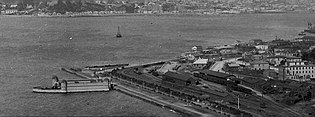Suburb in Wellington City, New Zealand
| Pipitea | |
|---|---|
| Suburb | |
 View of Pipitea from the Fran Wilde Walk View of Pipitea from the Fran Wilde Walk | |
| Coordinates: 41°16′28″S 174°47′01″E / 41.274466°S 174.783599°E / -41.274466; 174.783599 | |
| Country | New Zealand |
| City | Wellington City |
| Local authority | Wellington City Council |
| Electoral ward |
|
| Area | |
| • Land | 138 ha (341 acres) |
| Population | |
| • Total | 465 |
| Wadestown | Kaiwharawhara | |
| Thorndon |
|
(Wellington Harbour) |
| Wellington Central |
Pipitea is a central suburb of Wellington, in the Wellington region of New Zealand's North Island.
Geography
The new suburb of Pipitea was created and its boundaries were fixed at a meeting of the full Wellington City Council on 20 August 2003. After that time suburb changes must receive the further consent of the New Zealand Geographic Board.
The territory
The territory is the sites of Pipitea Pā and Old St Paul's on the inland side of Thorndon Quay, the reclaimed land east and south of Thorndon Quay and Hutt Road from along the shoreline from Kaiwharawhara to Whitmore Street, and the Government Centre bounded by Kate Sheppard Place (formerly Sydney Street East), Hill Street, Sydney Street West, Bowen Street and the reclaimed land.
Demographics
Pipitea
Pipitea, comprising the statistical areas of 7021731, 7021520, 7021521, 7021522, 7021523 (which has no permanent residents) and 7021524, covers 1.38 km (0.53 sq mi).
| Year | Pop. | ±% p.a. |
|---|---|---|
| 2006 | 444 | — |
| 2013 | 483 | +1.21% |
| 2018 | 465 | −0.76% |
| Source: | ||
Pipitea had a population of 465 at the 2018 New Zealand census, a decrease of 18 people (−3.7%) since the 2013 census, and an increase of 21 people (4.7%) since the 2006 census. There were 225 households, comprising 240 males and 225 females, giving a sex ratio of 1.07 males per female, with 30 people (6.5%) aged under 15 years, 141 (30.3%) aged 15 to 29, 249 (53.5%) aged 30 to 64, and 42 (9.0%) aged 65 or older.
Ethnicities were 78.1% European/Pākehā, 9.0% Māori, 2.6% Pasifika, 16.8% Asian, and 2.6% other ethnicities. People may identify with more than one ethnicity.

Although some people chose not to answer the census's question about religious affiliation, 52.3% had no religion, 32.9% were Christian, 5.2% were Hindu, 1.3% were Muslim, 1.9% were Buddhist and 3.2% had other religions.
Of those at least 15 years old, 210 (48.3%) people had a bachelor's or higher degree, and 9 (2.1%) people had no formal qualifications. 204 people (46.9%) earned over $70,000 compared to 17.2% nationally. The employment status of those at least 15 was that 321 (73.8%) people were employed full-time, 39 (9.0%) were part-time, and 12 (2.8%) were unemployed.
| Name | Population | Households | Median age | Median income |
|---|---|---|---|---|
| 7021731 | 66 | 33 | 37.1 years | $58,100 |
| 7021520 | 162 | 81 | 32.2 years | $53,400 |
| 7021521 | 54 | 21 | 35.2 years | $80,600 |
| 7021522 | 54 | 24 | 31.3 years | $65,700 |
| 7021524 | 129 | 66 | 41.8 years | $72,700 |
| New Zealand | 37.4 years | $31,800 |
Pipitea-Kaiwharawhara
Pipitea-Kaiwharawhara statistical area also includes the largely industrial suburb of Kaiwharawhara and covers 2.22 km (0.86 sq mi). It had an estimated population of 1,110 as of June 2024, with a population density of 500 people per km.

| Year | Pop. | ±% p.a. |
|---|---|---|
| 2006 | 597 | — |
| 2013 | 849 | +5.16% |
| 2018 | 960 | +2.49% |
| Source: | ||
Pipitea-Kaiwharawhara had a population of 960 at the 2018 New Zealand census, an increase of 111 people (13.1%) since the 2013 census, and an increase of 363 people (60.8%) since the 2006 census. There were 387 households, comprising 474 males and 486 females, giving a sex ratio of 0.98 males per female. The median age was 32.5 years (compared with 37.4 years nationally), with 78 people (8.1%) aged under 15 years, 354 (36.9%) aged 15 to 29, 444 (46.2%) aged 30 to 64, and 81 (8.4%) aged 65 or older.
Ethnicities were 77.8% European/Pākehā, 10.0% Māori, 2.5% Pasifika, 17.2% Asian, and 4.1% other ethnicities. People may identify with more than one ethnicity.
The percentage of people born overseas was 34.4, compared with 27.1% nationally.
Although some people chose not to answer the census's question about religious affiliation, 54.7% had no religion, 30.3% were Christian, 0.3% had Māori religious beliefs, 5.0% were Hindu, 0.6% were Muslim, 0.9% were Buddhist and 2.8% had other religions.
Of those at least 15 years old, 390 (44.2%) people had a bachelor's or higher degree, and 30 (3.4%) people had no formal qualifications. The median income was $52,400, compared with $31,800 nationally. 351 people (39.8%) earned over $70,000 compared to 17.2% nationally. The employment status of those at least 15 was that 558 (63.3%) people were employed full-time, 138 (15.6%) were part-time, and 39 (4.4%) were unemployed.
Economy
Retail
The Capital Gateway Centre shopping precinct has 13 stores, including Freedom Furniture.
References
- ^ "Statistical area 1 dataset for 2018 Census". Statistics New Zealand. March 2020. 7021731, 7021520, 7021521, 7021522 and 7021524.
- ^ "ArcGIS Web Application". statsnz.maps.arcgis.com. Retrieved 23 January 2024.
- "Aotearoa Data Explorer". Statistics New Zealand. Retrieved 26 October 2024.
- ^ "Statistical area 1 dataset for 2018 Census". Statistics New Zealand. March 2020. Pipitea-Kaiwharawhara (250700). 2018 Census place summary: Pipitea-Kaiwharawhara
- "Location – Capital Gateway". capitalgatewayretail.co.nz. Capital Gateway.
| Wellington City, New Zealand | |||||||||||
|---|---|---|---|---|---|---|---|---|---|---|---|
| Seat: Wellington Central | |||||||||||
| Suburbs |
| ||||||||||
| Geographic features | |||||||||||
| Government | |||||||||||
| Education | |||||||||||